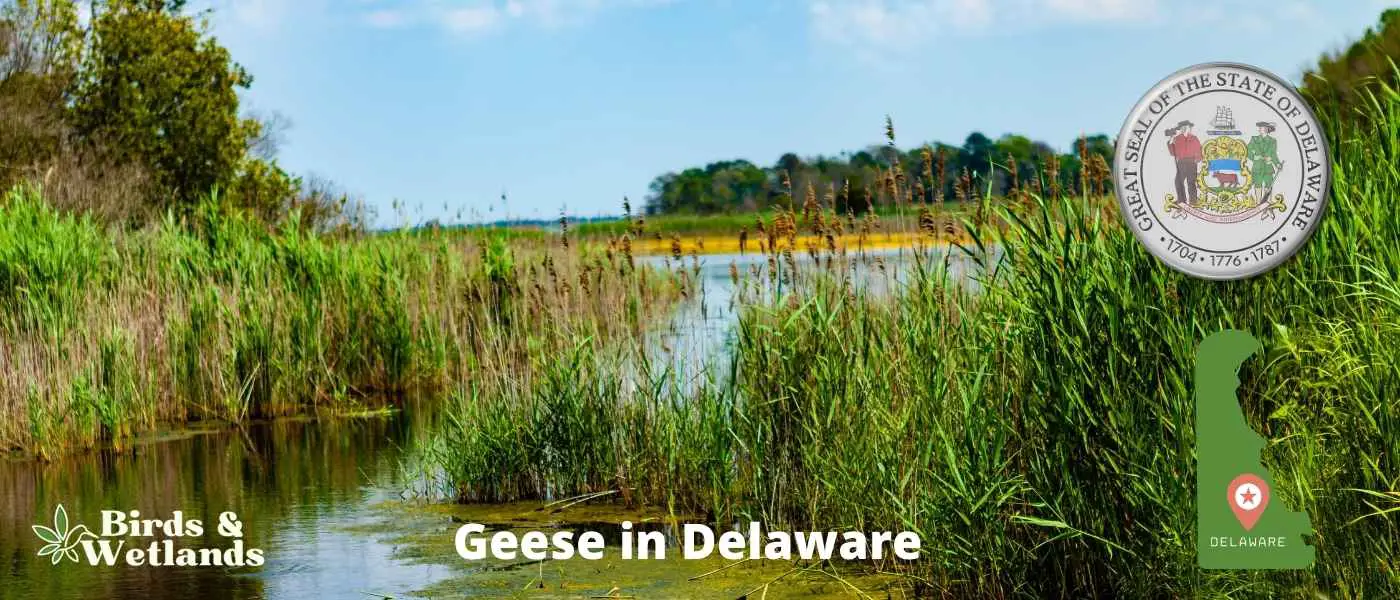Whether you’re hoping to get a glimpse of some rare geese or just enjoy the sight of a large flock flying overhead, Delaware is definitely worth a visit for geese watching. So pack your binoculars and head on down!
What Geese Are in Delaware?
There are 4 goose species and 3 swan species that call Delaware their home. These waterfowl species include:
- Canada Goose
- Snow Goose
- Cackling Goose
- Brant
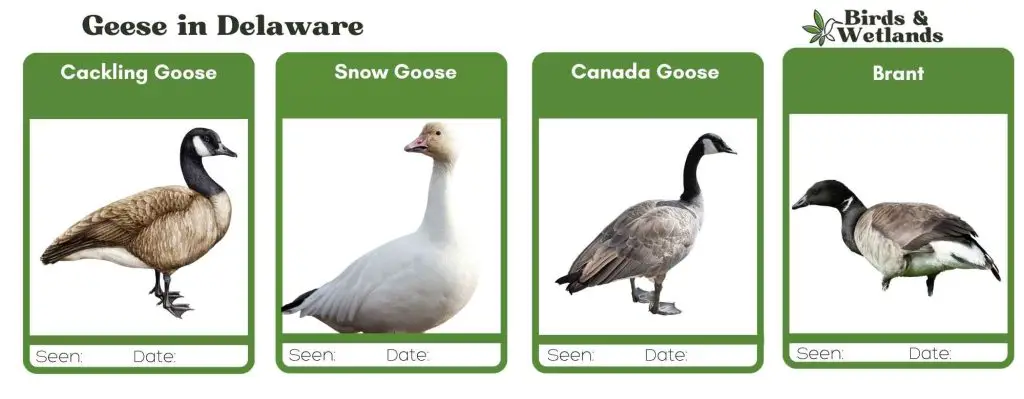
Canada Goose
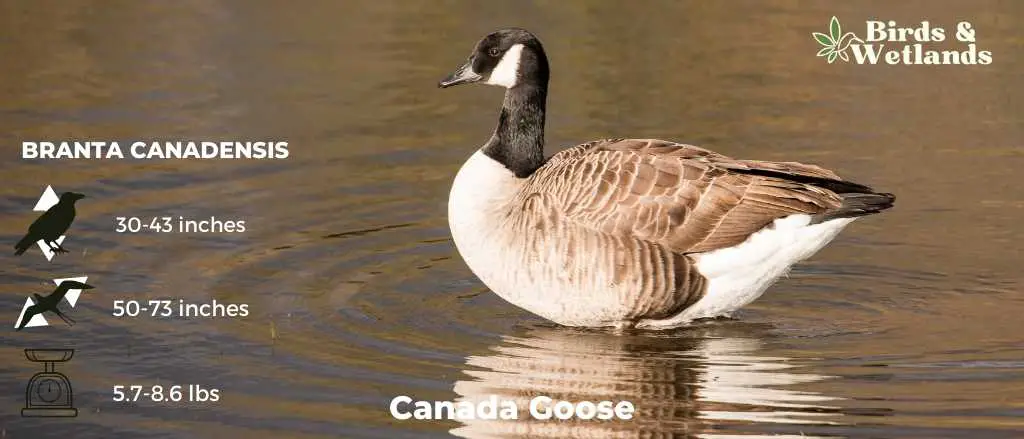
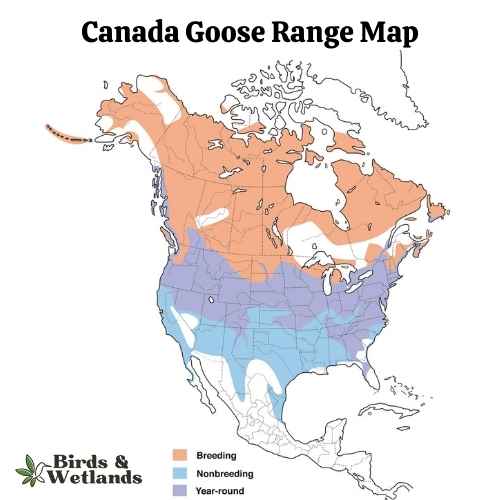
Canada Goose Sound
Scientific Name: Branta canadensis
Length: 30 to 43 in
Wingspan: 50–73 in
Weight: 5.7–14.3 lb
The Canada Goose is a large, well-known species of waterfowl noted for its distinctive appearance, familiar “honk,” and migratory behavior.
Appearance: Both male and female Canada Geese have a similar appearance, featuring a black head and neck with distinctive white patches on the cheeks and chin. The body is primarily brown with a lighter, often white, underbelly.
Diet: Canada Geese primarily feed on plant matter, including grasses, aquatic vegetation, and grains. They can often be seen grazing in parks, lawns, and fields, as well as dabbling in water bodies.
Reproduction: Canada Geese typically nest on the ground near water bodies, often on islands or other isolated areas to avoid predators. The female lays a clutch of about 4 to 6 eggs, which she incubates alone for around a month.
Snow Goose
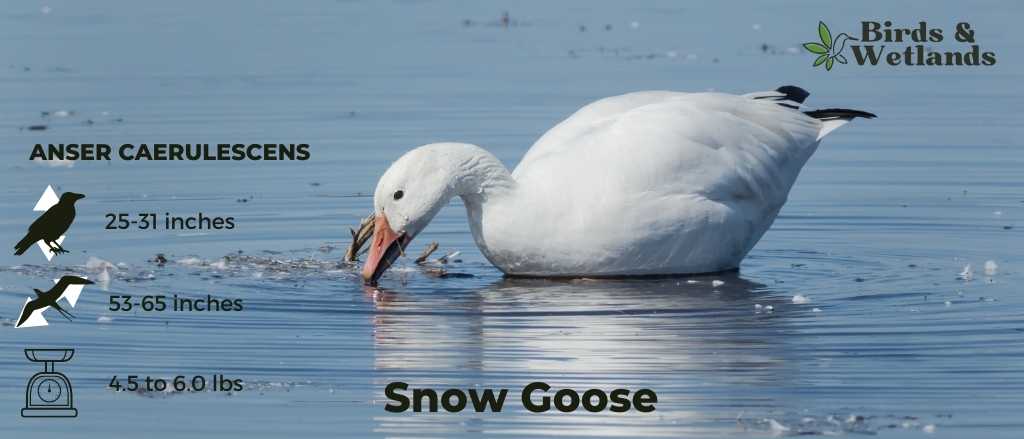
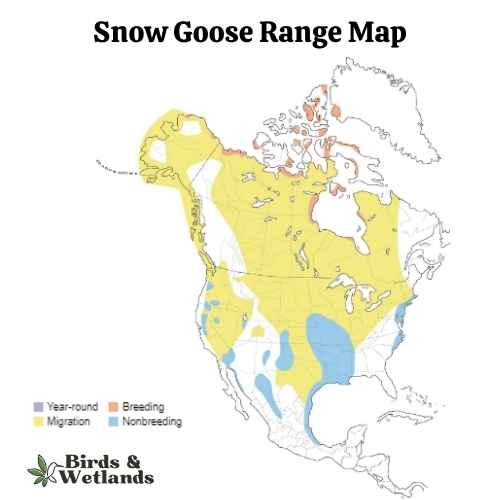
Snow Goose Sound
Scientific Name: Anser caerulescens
Length: 25 to 31 in
Wingspan: 53 to 65 in
Weight: 4.5 to 6.0
The Snow Goose is a large species of waterfowl known for its vibrant white plumage and significant migratory flights.
Appearance: True to their name, Snow Geese are predominantly white with black wingtips. They also have a pink bill, pink legs and feet. A color morph, known as the “Blue Goose,” displays a bluish-gray body with a white head, but is considered the same species.
Diet: Snow Geese primarily feed on plant matter, such as grasses, sedges, and small grains. They can often be seen in large flocks foraging in fields and marshes, and during migration and winter, they can cause considerable damage to agricultural fields due to their feeding habits.
Reproduction: Snow Geese typically nest on the tundra, near water bodies. The female builds the nest and lays a clutch of about 3 to 5 eggs, which she incubates alone for approximately three weeks. Once hatched, the goslings can feed themselves but stay with their parents for protection until they can fly.
Cackling Goose
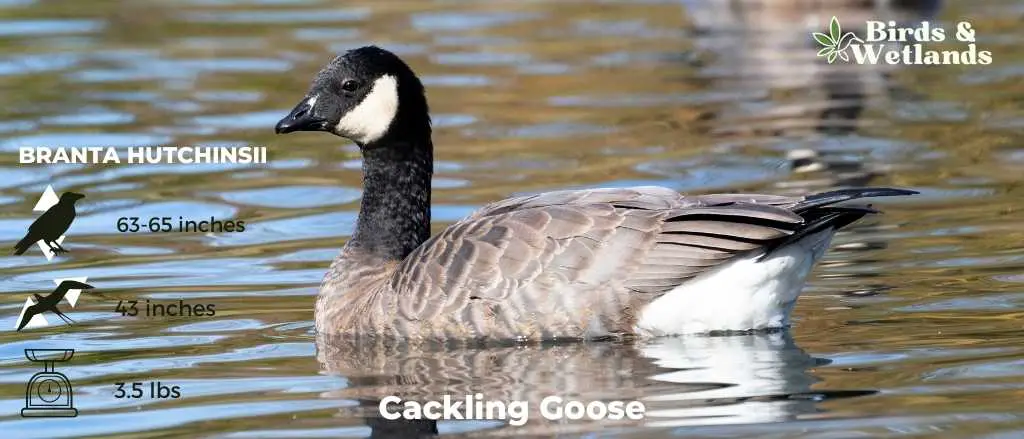
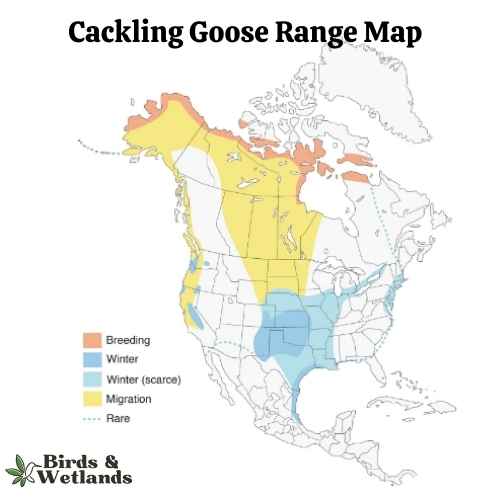
Listen
Scientific Name: Branta hutchinsii
Length: 24.8–25.6 in
Wingspan: 43-45.7 in
Weight:3.5 lbs
Cackling Geese are particularly known for their high-pitched, cackling calls, which is the source of their name. Despite their small size, these geese are renowned long-distance migrants, with some populations traveling thousands of miles between breeding and wintering grounds.
Appearance: With a similar color pattern to the larger Canada Goose, the Cackling Goose features a black head and neck, white chinstrap, light tan to cream chest, and brownish-grey body. One defining characteristic is its noticeably smaller size and stubbier neck compared to its larger counterparts.
Diet: Like many geese, the Cackling Goose’s diet mainly consists of plant matter. This includes grasses, seeds, and aquatic vegetation. They are often seen grazing on land or dabbling in shallow water.
Reproduction: Cackling Geese usually nest on the ground in elevated areas near water bodies, such as riverbanks or lakeshores. The female lays a clutch of 2 to 8 eggs and is responsible for incubation, while the male stands guard nearby. Incubation lasts for about a month.
Brant
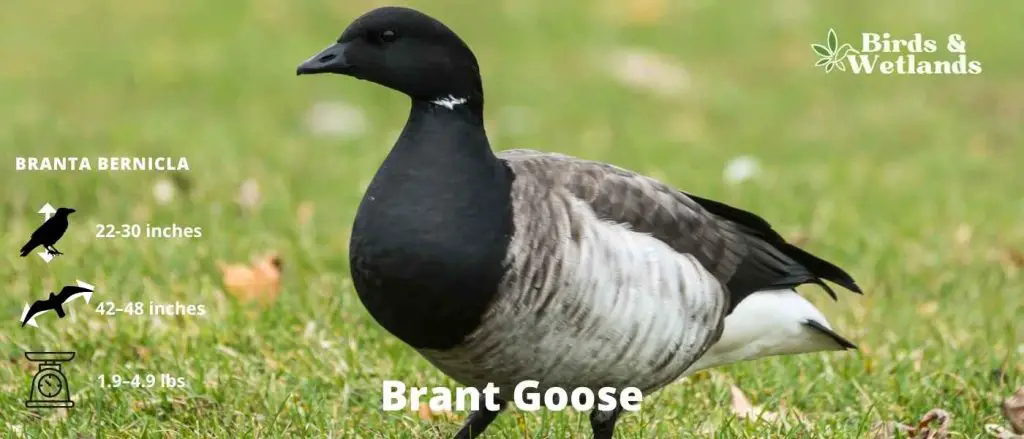
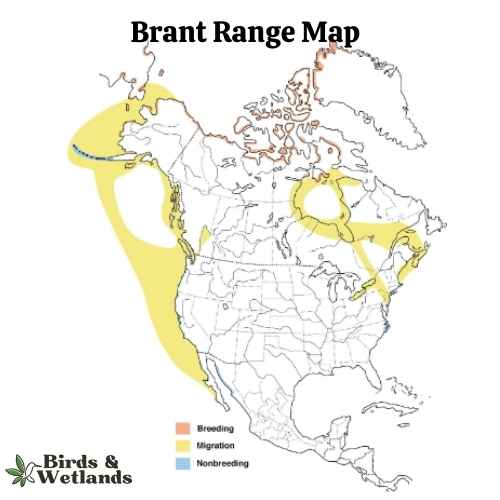
Listen
Scientific Name: Branta bernicla
Length: 22–26 in
Wingspan: 42–48 in
Weight: 1.9–4.9 lb
The Brant is a compact species of goose that is known for its striking appearance and interesting migratory patterns.
Appearance: The Brant is recognized for its dark, sooty color with a white crescent on the neck. The body is mostly black to dark gray, contrasting with the lighter underparts. Its small size, as compared to other geese, and short, stubby bill are other distinct features.
Diet: The Brant’s diet primarily consists of aquatic plants, especially eelgrass and sea lettuce. During the breeding season, they may also feed on grasses, sedges, and insects.
Reproduction: Brants typically breed in the high Arctic tundra. The female lays a clutch of 3 to 5 eggs in a ground nest, which she incubates for about a month.
Notably, Brants make an impressive long-distance migration every year. They spend their winters along both the east and west coasts of the United States and travel to the Arctic regions of Canada, Alaska, and even Russia to breed.
Does Delaware Have A Resident Goose Flock?
Delaware is home to two species of resident geese: the Canada Goose and the Snow Goose. Both of these birds are year-round residents, meaning they don’t migrate south for the winter.
The Canada Goose is the most common goose in Delaware, and you’re likely to see them in parks and other open areas. They’re easily identified by their black neck and white chin.
Snow Geese are much less common, but they can be found in some parts of the state.
Hunting Geese in Delaware
Delaware is a great place for hunting geese. To hunt geese in Delaware, you’ll need to get a Delaware hunting license.
Can You Shoot a Goose in Delaware?
Yes, you can hunt geese in Delaware. Each county in the state has different regulations so be sure to check them before you do your hunting.
Where Can I Hunt Geese in Delaware?
One of the most popular places to hunt geese in Delaware is the Augustine Wildlife Area.
The Augustine Wildlife Area consists of two tracts of land: the Port Penn tract and the Ashton tract.
Check the full list of areas where hunting geese is allowed here.
Is There a Goose Hunting Season in Delaware?
Goose hunting in Delaware usually starts in September and ends either late February or early March.
What is Delaware’s Snow Goose Conservation Order?
The Snow Goose Conservation Order which takes place in February is a special season when hunters are able to use liberal harvest methods to help reduce the snow goose population.
This is necessary because the large snow goose population is damaging its Arctic nesting grounds, as well as wetlands and agricultural lands on migration routes and overwintering areas.
Interestingly, the state of Delaware holds a special youth waterfowl hunting day. This day is open to hunters aged 10 through 15, and it provides a great opportunity for young people to learn about waterfowl hunting and get out into nature.
Normal daily waterfowl bag limits apply during the special youth waterfowl hunting day, so it’s important to be familiar with the regulations before heading out.
The special youth waterfowl hunting day is a great way for young hunters to get started in the sport, and it’s sure to create lasting memories.
Conclusion on Geese in Delaware
If you’re looking for an interesting fact about Delaware wildlife, now you know that there are four types of geese and three types of swans.
Make sure to keep your eyes peeled the next time you’re out exploring Delaware’s natural areas; you may be lucky enough to spot one of these beautiful creatures in the wild!

